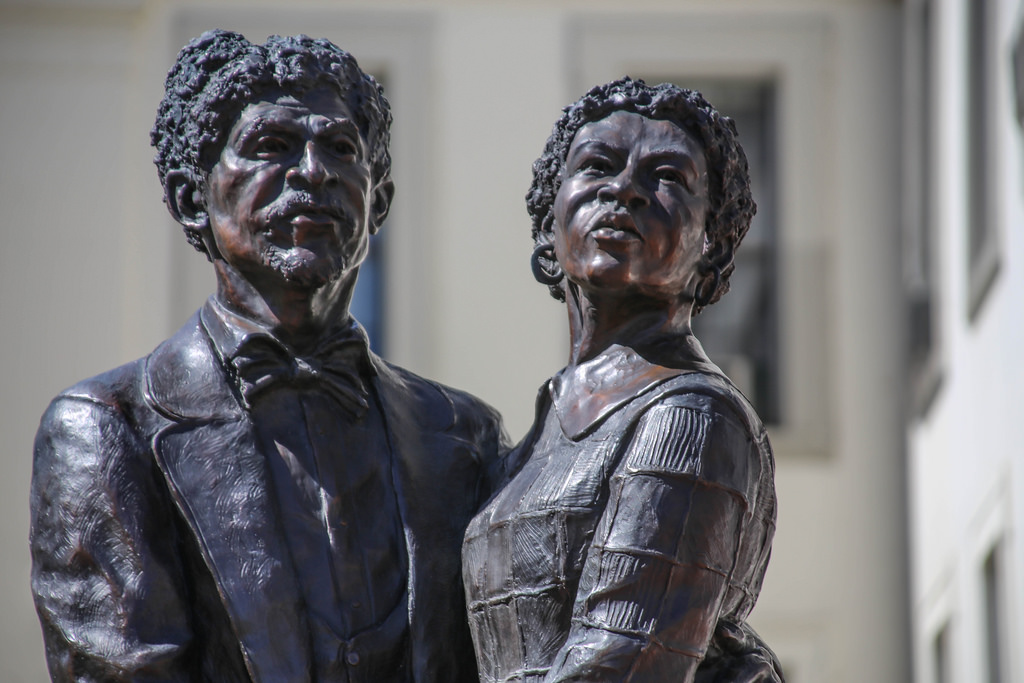Trump’s America Raises the Ghost of Dred Scott
Echoes of the most odious ruling in the Supreme Court's history can be heard in the president's white supremacist rhetoric. A statue of Dred and Harriet Scott at the Old Courthouse in downtown St. Louis. (Paul Sableman / CC BY 2.0)
A statue of Dred and Harriet Scott at the Old Courthouse in downtown St. Louis. (Paul Sableman / CC BY 2.0)
Shortly after midnight on Aug. 18, 2017, just days after the neo-Nazi march on Charlottesville, Va., workers arrived on the grounds of the Maryland Statehouse to remove a statue of Roger B. Taney, the man who authored the lead opinion in the case of Dred Scott v. Sandford as chief justice of the U.S. Supreme Court in 1857. Generally regarded as the most odious ruling in the high court’s history, the Dred Scott decision held that African-Americans, wherever they resided, could never be U.S. citizens. The decision also held that the Missouri Compromise of 1820—which had outlawed slavery west of Missouri and north of latitude 36º30′—was unconstitutional.
The morning before Taney’s memorial was taken down, President Donald Trump took to Twitter to condemn similar undertakings in other locations across the country:
“Sad to see the history and culture of our great country being ripped apart with the removal of our beautiful statues and monuments. You can’t change history, but you can learn from it.”
Ironically, the president’s tweet, while vile and typically uninformed, wasn’t entirely wrong. You can learn from history, to be sure. When it comes to Confederate monuments, you can learn a lot about the history of American racism in general.
And when it comes to the monuments, especially the Taney statue, you can learn a lot about the racism of our current commander in chief.
Trump’s racism stretches back decades to his formative years in the 1970s as a young New York City real estate developer, when the Justice Department accused him and his father of housing discrimination. The president’s racist past also includes, but is by no means limited to, the full-page ads he took out in New York City newspapers in 1989 to urge the death penalty for five black and Latino teenagers who had been accused of brutally raping a white woman in Central Park. Although they were convicted, the five defendants were vindicated in 2002 after another man confessed to the rape, and DNA testing corroborated his guilt.
During Barack Obama’s presidency, Trump was a leading proponent of the “birther movement” that alleged Obama was born in Kenya, and was thus ineligible to serve as president. More recently, Trump referred to some of the alt-right Charlottesville rioters as “very fine people.”
And at an Oval Office meeting on immigration policy earlier this month, the president referred to Haiti, El Salvador and the nations that make up the African continent as “shithole countries.” He reportedly asked why the U.S. had to accept immigrants from such places rather than from a country like Norway—a predominantly white, Western European nation.
It’s easy to dismiss, as many in Democratic Party circles have, Trump’s racism as aberrant and unique. Sadly, however, it isn’t. Rather, it is deeply—and intricately—entrenched in our political culture.
To understand the historical roots and ideological underpinnings of Trump’s white supremacist beliefs, Taney’s opinion in the Dred Scott case is a good place to start. Contrary to what most of us are taught in high school civics classes, the case is by no means a relic of the past pertinent only to the institution of slavery. It is also a conduit to the bigotry of the present.
As law professors Jack Balkin of Yale University and Sanford Levinson of the University of Texas wrote in a 2007 article for the Chicago-Kent Law Review, the Dred Scott case remains “relevant to almost every important question of contemporary constitutional theory.” In particular, Balkin and Levinson argue, “The twin questions that Dred Scott posed and answered in 1857—who is an American and to whom does America truly belong—are still with us today.” Trump’s “Make America Great Again” and “America First” slogans and his white-nationalist agenda are the latest iterations of the perennial debate.
Dred Scott himself could hardly have anticipated the meaning his legal fight for freedom and inclusion in the body politic would have for succeeding generations of Americans, much less the Trump presidency. Although little is known of his early years, according to the legal historian Paul Finkelman, Scott was born a slave in Virginia between 1795 and 1800. He was illiterate, and when fully grown stood a scant 5 feet tall.
Like many slaves in the antebellum South, Scott had multiple owners in his life. He also was moved around a lot. His first master took him westward to Alabama and eventually to St. Louis. Two years later, Scott was purchased by John Emerson, an Army surgeon, who moved Scott again, first to the free state of Illinois and then in 1836 to Fort Snelling in what is now Minnesota. (It was then part of the Wisconsin Territory, where slavery had been prohibited by the Missouri Compromise.)
In Wisconsin, Scott married another slave, Harriet Robinson, who was owned by a local justice of the peace. The couple remained in Wisconsin until 1838, when they journeyed to Fort Jesup in Louisiana to meet up with Emerson, who had been transferred there and had married a woman named Irene Sanford.
After a few months in Louisiana, the Scotts returned to Fort Snelling with Emerson and his wife in 1838, and remained there until 1840, when Emerson took them to St. Louis.
After Emerson died suddenly at age 40 in 1843, Irene inherited both Dred and Harriet. For the next three years, she hired out the Scotts to other people. It was this practice that apparently prompted Dred and Harriet to sue for their emancipation in 1846.
For the next 11 years, as their case made its way through the Missouri state legal system and then the federal courts, the Scotts were represented by a series of abolitionist lawyers who worked on a pro bono basis. Management of the defense side of the litigation was handled by Irene’s brother, Jack Sanford.
Finally, the case came before Taney and the U.S. Supreme Court, which by virtue of a court reporter’s typographical error added a second “d” to Sanford’s name, misspelling the title of the case for posterity in the official records as Dred Scott v. Sandford.
Misspelling aside, the question before the high court was whether Dred and Harriet were citizens who had the legal standing to bring their lawsuit in the federal courts. Their legal team argued that they were indeed citizens under a line of prior court rulings issued by state courts that had relied on English common law to hold that slaves could achieve their freedom by moving to and establishing domicile in free states or territories. The Scotts maintained that they had done so because Dred had lived in Illinois and both he and Harriet had lived at Fort Snelling.
The deck, however, was stacked against them in the Supreme Court. Four of the nine justices were slaveholding Southerners. Although four others hailed from Northern states, only one, according to Finkelman, was a known opponent of slavery.
Chief Justice Taney, who came from the slaveholding border state of Maryland, was a former slave owner. And while he had freed his own slaves after winning a seat in the Maryland legislature in 1816, Taney became an impassioned defender of slavery after he was appointed attorney general by President Andrew Jackson in 1831. He was nominated to the court in 1836.
“By the 1850s,” Finkelman writes, “Taney was a seething, angry, uncompromising supporter of the South and slavery and an implacable foe of racial equality, the Republican Party, and the antislavery movement.”
The Scotts lost their case in the Supreme Court by a vote of 7-2. Each of the justices produced separate opinions that together filled 260 pages.
Taney’s 54-page majority opinion represented a complete victory for the slave-ocracy that dominated the Democratic Party of the era. In what would be considered today an “originalist” interpretation of the Constitution, Taney insisted that the founders of the United States never intended to confer citizenship on black people.
Reframing the central issue before the court, Taney asked at the outset of his opinion: “Can a negro whose ancestors were imported into this country and sold as slaves become a member of the political community formed and brought into existence by the Constitution of the United States, and as such become entitled to all the rights, and privileges, and immunities, guarantied [sic] by that instrument to the citizen … ?”
Taney answered himself in the negative: “We think they [black people] are not, and that they are not included, and were not intended to be included, under the word ‘citizens’ in the Constitution.”
If the answer were yes, Taney warned, blacks would, for example, have “the full liberty of speech in public and in private upon all subjects upon which … citizens might speak; to hold public meetings upon political affairs, and to keep and carry arms wherever they went.”
Such an outcome was unthinkable, Taney concluded, because “[Negroes were] beings of an inferior order, and altogether unfit to associate with the white race, either in social or political relations; and so far inferior, that they had no rights which the white man was bound to respect.”
Although Taney’s opinion dealt with slavery, its reasoning is far broader, and directly applicable to the policies and rhetoric of President Trump because of the linkages it draws among race, status, citizenship and community. Echoes of these linkages, as Balkin and Levinson argue, “are still with us whenever we assume that one race is more centrally ‘American’ than others and more clearly and obviously a part of the American people and the American political community.”
For Taney and also, unfortunately, for Trump, America was and remains principally a white nation descended from European immigrants. Substitute “illegal aliens” or DACA “Dreamers” or prospective immigrants from “shithole” countries for the “Negroes” reviled by Taney and you have today’s “others”—the perpetual and dangerous outsiders stigmatized by Trump and his enablers, who should never be admitted to the country or welcomed and embraced as citizens.
It took the Civil War and the enactment of the 13th, 14th and 15th Amendments to overturn the Dred Scott decision as controlling legal precedent. But the hatred and racism of the case endures, embedded in the national narrative and psyche, as the 45th president of the United States reminds us nearly every single day.
Your support matters…Independent journalism is under threat and overshadowed by heavily funded mainstream media.
You can help level the playing field. Become a member.
Your tax-deductible contribution keeps us digging beneath the headlines to give you thought-provoking, investigative reporting and analysis that unearths what's really happening- without compromise.
Give today to support our courageous, independent journalists.








You need to be a supporter to comment.
There are currently no responses to this article.
Be the first to respond.